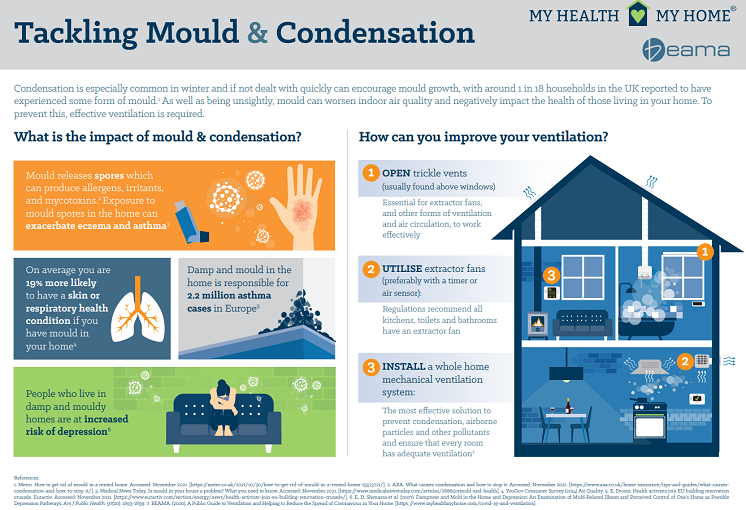
As the UK enters a crucial winter period, trade association BEAMA has today issued clear ventilation guidance to tackle mould.
The BEAMA hope the new advice will help boost much-needed public understanding surrounding the impacts of condensation and mould, and act as a valuable resource for industry.
The guidance, which highlights the serious health impacts caused by a build-up of condensation and mould in the home, spotlights three key ventilation solutions to help tackle the problem: utilise extractor fans, open trickle vents and install whole home ventilation systems.
It is hoped that the guidance will help drive a greater understanding of the impact mould can have on our health and wellbeing and the importance of ventilation, while equipping the public with the ventilation solutions to tackle the problem.
Airtight homes The guidance is timely given condensation is particularly common in winter, as homes are kept airtight to keep in the warmth and conserve energy. An airtight home often means there is little to no natural ventilation occurring to help remove excess moisture which encourages mould growth. Mould growth is dangerous as it releases spores that can contribute to a build-up of indoor air pollutants, producing allergens, irritants and mycotoxins which put the health of those living in the home at risk.1
With the Government Net Zero strategy and the energy price crisis, people are focusing more than ever on ensuring their homes are energy efficient and sufficiently insulated this winter. Whilst this conserves energy, it also threatens to compromise the ventilation of homes across the UK and create or exacerbate mould issues.
Health protection With around 1 in 18 households in the UK experiencing some form of mould,2 it is vital the public understand the importance of ventilation for reducing mould, delivering improved indoor air quality, and ultimately protecting their personal health and well-being. Therefore, the need for simple guidance that the public can follow to help improve the ventilation in their homes is essential.
Commenting on the new guidance, Colin Timmins, Director of Building Technologies at BEAMA has said: “Public understanding on the importance of ventilation for our health and wellbeing is worryingly low, yet fundamental to making a lasting and impactful change. With this ventilation guidance on how to tackle mould, BEAMA aims to support the public as we winter a critical winter period, while providing industry with a useful took to help drive public understanding.”
Indoor Air Quality (IAQ) In addition to the higher rate of COVID-19 transmission indoors, the wider health impacts of poor indoor air quality (IAQ) are well documented. Poor IAQ is reported to have an annual cost to the UK of over 204,000 healthy life years,3 with 45% of those lost to cardiovascular diseases, 23% to asthma and allergy, and 15% to lung cancer. In 2012 the World Health Organization reported that indoor air pollutants were responsible for around 99,000
European deaths a year.4 The Royal College of Physicians warning that indoor air pollutants cause, at a minimum, thousands of deaths per year in the UK and are associated with healthcare costs in the order of “tens of millions of pounds”.5
References
- AXA: 'What causes condensation and how to stop it.'
- Metro: 'How to get rid of mould in a rented home.'
- National Institute for Health and Welfare. Efficient reduction of indoor exposures: 'Health benefits from optimizing ventilation, filtration and indoor source controls.' 2013.
- World Health Organisation (WHO): 'Burden of disease from household air pollution for 2012.' 2014.
- Royal College of Physicians: 'Every breath we take: the lifelong impact of air pollution. Report of a working party.' 2016.






